Like Vata, the great Ayurvedic concept of Pitta, the symbolic agent for “biological energy,” is a very broad term in its meanings and applications. In order to be properly understood, identified, and applied for medical purposes, it must be investigated in detail with regards to its different manifestations. In this chapter we present Pitta from eight points of view:
- Pitta in the Sense of Fire and Bile
- Pitta in the Sense of Tastes
- Pitta in the Sense of the Vein System
- Pitta in the Sense of Health
- Pitta in the Sense of Disease
- Pitta in the Sense of Aggravating Agent
- Pitta in the Sense of Diagnosis
- Pitta in the Sense of Treatment
Pitta in the Sense of Fire and Bile
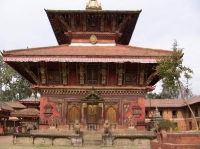 Fire is a word-symbol for heat. Physical fire is indicative of the innate nature of the metaphysical “Fire Element.” The heat of physical fire is easy to understand, but the heat of the Fire Element is not. This is because the Fire Element in the construction of objects (including the physical body) exists in different forms that can be identified only by reference to the physical properties of the Fire Element. The ancient Ayurvedic sages pointed out that the physical properties of both the Fire Element and physical fire are very similar to those of the biological fire called Pitta, and that the physical properties of Pitta are very similar to those of bile. The physical properties of both Pitta and bile are Usna (heat), Tiksna (strong sensation), Drava (liquid), Sara (movable) and Sneha (greasy). In this sense, the metaphysical element fire, the fire that burns in the atmosphere, the fire of the body (body metabolism) and the bile substance, although they are not the same, are related to each other by virtue of their shared physical properties.
Fire is a word-symbol for heat. Physical fire is indicative of the innate nature of the metaphysical “Fire Element.” The heat of physical fire is easy to understand, but the heat of the Fire Element is not. This is because the Fire Element in the construction of objects (including the physical body) exists in different forms that can be identified only by reference to the physical properties of the Fire Element. The ancient Ayurvedic sages pointed out that the physical properties of both the Fire Element and physical fire are very similar to those of the biological fire called Pitta, and that the physical properties of Pitta are very similar to those of bile. The physical properties of both Pitta and bile are Usna (heat), Tiksna (strong sensation), Drava (liquid), Sara (movable) and Sneha (greasy). In this sense, the metaphysical element fire, the fire that burns in the atmosphere, the fire of the body (body metabolism) and the bile substance, although they are not the same, are related to each other by virtue of their shared physical properties.
Heat is the real signifier of the Fire Element. Heat affecting any object immediately counteracts its coldness. Any object affected by the power of heat is termed hot. The counteraction of cold by heat means that the cold nature of the water and Air Elements escapes from the physical structure of any object that is heated. The coldness of the water and Air Element has a natural struggle with the heat of the Fire Element. In another sense, if the power of heat is strong enough, water and air cannot stand against it and try to escape. This is a law of nature. It is the nature of heat to try to make air and water come under its control. This is seen when any object affected by heat becomes hotter, drier (less water) and smaller (less air). Bile is designated by Ayurveda to be the major representative in the body of the Fire Element. The heat of bile counteracts with the representatives of the bodily water and Air Element. As bile or its properties increase in relative proportion against bodily water and air, more inflammation and heat sensation is experienced.
Any object affected by heat or fire can be identified by a “strong sensation” which is called Tiksna. This strong sensation is the reaction of the stability of water fighting against the power of heat. For example, water reacting against sudden strong heat tries to fight against it by exploding. The sensation created by the explosion is an example of the strong sensation called Tiksna by Ayurveda. The strong sensation or Tiksna is counteractive to Manda, the mild or bland state of water when not disturbed by heat.
Elements of any object affected by heat begin to decompose. During the process of decomposition, the Water Element (by nature liquid or Drava) first separates from the physical construction of the objects. Then the water carries other elements including the Fire Element in their microform stage away, because water is the best solvent. The Water Element containing the released elements moves here and there. The mobile nature of water is called Sara. Highly concentrated water containing elements decomposed by fire plays the role of liquid energy. Thus, we can understand by analogy that the bile, a byproduct of blood decomposition, plays the role of bodily fire. It is fire energy in liquid form.
The Elements are in constant interaction in the universe. To exist without being destroyed by fire, the Water Element must protect by itself by releasing its greasy components. Grease counteracts the dryness that fire causes. Within the body, to exist as the Fire Element, the bile must in the same way contain some grease (Sneha) to counteract dryness.
The Five Biles
Following this analysis of the physical properties shared by the Fire Element and bile, we can understand the logic by which the medical word Pitta can be translated in the sense being the biological fire of the body called bile. However, in Ayurvedic thought, although Pitta includes the bile of the gall bladder, the term also includes other forms of vital biological fire. These biological fires have different roles to play in the function of the body.
The medical term Pitta includes five different forms of bodily fire necessary for proper physical functioning of the body. These bodily fires or vital biles are called Pachaka, Ranjaka, Sadhaka, Alochaka and Bhrajaka.
- Pachaka Pitta is the vital bile that is located within the gall bladder and its duct system. This vital bile is the main source of the other forms of vital bile, and its main function is to digest food.
- Ranjaka is the vital bile that is located in the liver and spleen. Its main function is to provide red color for staining the blood.
- The vital bile Sadhaka is active in the heart. The main function of its fire is to stimulate the activity of mind and the brain.
- The vital bile Alochaka is located in the eyes. The main function of Alochaka is to provide the power of vision.
- The vital bile Bhrajaka is located in the skin, where it stimulates the activities of the skin.
Although these vital biles have different functions, they are composed of the same fundamental substance. They all share the identical same five physical properties of Pitta.
Pitta in the Sense of Taste
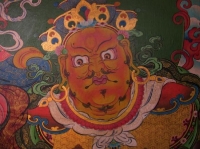 It was mentioned before that the foods and herbs with sour, pungent and salty tastes contain more Fire Element. They contain more of the physical properties of the bile formula and so are considered as matter that strengthens the power of the bile formula in the body. Matter that strengthens the power of the bile formula is called Pittala, meaning “that which causes more heat or bile.” The proper use of sour, pungent and salty tasting foods, herbs or drugs causes balance of the Pitta substance. Excessive use or daily use of them results in the over-balance of the Pitta substance. Balance of the Pitta substance is necessary to supply regular heat in the body. Over-balance of Pitta means to have more heat or inflammation that is destructive to the body construction.
It was mentioned before that the foods and herbs with sour, pungent and salty tastes contain more Fire Element. They contain more of the physical properties of the bile formula and so are considered as matter that strengthens the power of the bile formula in the body. Matter that strengthens the power of the bile formula is called Pittala, meaning “that which causes more heat or bile.” The proper use of sour, pungent and salty tasting foods, herbs or drugs causes balance of the Pitta substance. Excessive use or daily use of them results in the over-balance of the Pitta substance. Balance of the Pitta substance is necessary to supply regular heat in the body. Over-balance of Pitta means to have more heat or inflammation that is destructive to the body construction.
The sweet, bitter and astringent tastes in general impart a cooling sensation. That means they contain more water, earth and Air Elements that have the property of being cooling (Shita). In this sense, the sweet, bitter and astringent tastes counteract the sour, pungent and salty tastes. Excessive use of sweet, bitter and astringent tastes in the form of foods or drugs by nature cause under-balance of the Pitta substance. This means that they cause the natural temperature of the body to go down.
Pitta in the Sense of the Vein System
 Ayurveda explains that the vital bile signifies bodily heat that depends upon the blood circulation for distribution in the tissues. Blood is the red fluid of the body, and the red color of blood is one of the five vital biles of the body. This red-colored biological fire by nature generates heat. The arteries and veins are the carriers of the blood. Both contain blood, but the blood in the arteries is sweeter than the blood in the veins. This is because the blood of the artery contains more serum with the essence of food that is sweet. Venous blood contains less serum and more pungent and sour byproducts such as bile. Following this fact, it is clear that the vein system generates more heat in the body than the artery system. Therefore, the function of the venous system is regarded in general as a place where Pitta concentrates. Diseases of Pitta character can be subdued by taking blood out of the veins that is the basis of the practice of bloodletting (venesection – see page 71).
Ayurveda explains that the vital bile signifies bodily heat that depends upon the blood circulation for distribution in the tissues. Blood is the red fluid of the body, and the red color of blood is one of the five vital biles of the body. This red-colored biological fire by nature generates heat. The arteries and veins are the carriers of the blood. Both contain blood, but the blood in the arteries is sweeter than the blood in the veins. This is because the blood of the artery contains more serum with the essence of food that is sweet. Venous blood contains less serum and more pungent and sour byproducts such as bile. Following this fact, it is clear that the vein system generates more heat in the body than the artery system. Therefore, the function of the venous system is regarded in general as a place where Pitta concentrates. Diseases of Pitta character can be subdued by taking blood out of the veins that is the basis of the practice of bloodletting (venesection – see page 71).
The function of the vein system controls and regulates the functions of the nervous system and the artery system and the vein system itself is controlled and regulated by them. For demonstration, use of sour, pungent and salty tasting substances (which cause heat) can be used to stimulate the vein system. The stimulated vein system becomes powerful and will control and regulate the function of the nervous system and the artery system. Deficiency of the sour, pungent and salty tastes results in weak functioning of the vein system. In this condition, the vein system cannot control and regulate the functions of the nerve and artery systems. The combination of sour, pungent and salty tastes is organized in the sense that the pungent taste helps regulate the artery system and the sour and salty taste help regulate the nervous system.
By way of these demonstrations, it is clear that the proper use of the sour, pungent and salty tastes is necessary to maintain the balance of the vein system. Overuse of the same substances results in over-balances of the vein system. The combination of the cooling sweet, bitter and astringent tastes is counteractive to the sour, pungent and salty tastes. Excessive uses of the sweet, bitter and astringent tastes cause under-balance of the vein system, and the proper use of them restores the balance.
Pitta in the Sense of Health
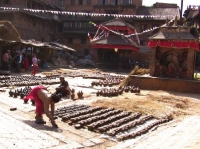 Health results from the balance of the three bodily substances. Their balance maintains the proper amount of each of the five elements, important for balance in the natural construction of the body. Pitta symbolizes the Fire Element of the body. It generates the energy that signifies the action of life.
Health results from the balance of the three bodily substances. Their balance maintains the proper amount of each of the five elements, important for balance in the natural construction of the body. Pitta symbolizes the Fire Element of the body. It generates the energy that signifies the action of life.
Energy is everywhere. It can be located in the atmosphere and in the physical construction of solid objects. The heat of the sun generates the energy of the atmosphere. Foods or herbs that are sour, pungent and salty in taste stimulate energy generation in the physical body construction. This is because foods with these tastes contain relatively more Fire Element and less of the other elements. For health, it is necessary to keep the Fire Element in proper balance. Exposure to the heat of the sun or fire must be regulated in the proper way and the proper amount. In the same way, the stimulating heat from foods or herbs which contains heat-generating elements must also be regulated. This regulation is necessary to balance opposing atmospheric effects (such as heat, cold or damp) as well as the opposing effects of different types of foods or herbs on the organism. This is a general rule. Another rule is that any food or herb that causes heat or has a strong sensation on the tongue is considered a supplier of the Fire Element, regardless of its taste.
Maintenance of the Fire Element (heat) in proper amounts results in optimal functioning of the vein system and the balance of the Pitta substance. The balanced Pitta substance maintains proper metabolism within and among the ingredients of the body. This is very important for health.
Pitta in the Sense of Disease
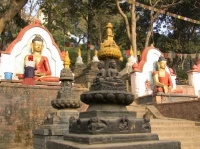 An under-balanced or over-balanced condition of the Pitta substance causes diseases related to the vein system, altering the energy and heat of the body. Under-balance or imbalance of the Pitta substance is called Pitta Kshaya, and its over-balance is called Pitta Vriddhi or Kruddha Pitta. The under-balance of Pitta substance means the Fire Element or the physical properties of the bile formula have become less in their natural proportion of the bodily construction. The over-balance of Pitta substance means the Fire Element or the physical properties of the bile formula have become higher in their natural proportions within the bodily construction.
An under-balanced or over-balanced condition of the Pitta substance causes diseases related to the vein system, altering the energy and heat of the body. Under-balance or imbalance of the Pitta substance is called Pitta Kshaya, and its over-balance is called Pitta Vriddhi or Kruddha Pitta. The under-balance of Pitta substance means the Fire Element or the physical properties of the bile formula have become less in their natural proportion of the bodily construction. The over-balance of Pitta substance means the Fire Element or the physical properties of the bile formula have become higher in their natural proportions within the bodily construction.
In general, the Pitta substance should be bitter and pungent. In the over-balanced stage, the Pitta substance becomes excessively sour in taste. When the physical properties of the bile formula go down in proportion, the vein system by nature becomes less active or inactive. When the physical properties of the bile formula go up in proportion, the vein system in the same way becomes overactive.
Over-activity or under-activity of the vein system in any organ or part of the body causes many physical disorders. Inactivity of the venous system in any body part or organ will cause poor blood circulation, reduced temperature and weak metabolism. Digestion will also weaken. Over-activity within the vein system results in excessive blood flow, increased heat and accumulation of bile in the affected areas. Heat sensations, inflammation, infection, burning pain, decay or rot, perspiration and discharge are the characteristic physical disorders.
Pitta Vikara / Diseases of the Pitta System
The disease processes listed here are the ones most commonly listed in the early texts. This list is by no means exhaustive.
- Hot sensations (whether inside the body or outside, for the entire body or only a local area)
- Acid burping
- Heartburn
- Excess perspiration
- Bad smelling sweat
- Ulcers
- Lesions or breaks in the skin or tissue
- Areas of red, raw tissue
- Hematorrhea
- Herpes zoster
- Blue cataract
- Hepatitis
- Stomatitis
- Bitter taste in the mouth
- Increased thirst
- Inflammation of the mouth, throat, eyes, anus or penis
- Blurred vision
- Fevers
Symptoms of Pitta Dysfunction
Besides the classical Pitta health problems connected with an overactive venous system, there are several typical diseases, conditions and/or symptoms that point towards an overactive vein system:
- Yellow, green or red color appearing on the face or over the affected area
- Slight greasy condition in the affected area.
- Yellowness seen in the urine, stool, skin, color of the nails, conjunctive of the eyes, or mucous membrane of the mouth
- Pain and other related symptoms worse while digesting food
- Pain feels worse when pressing the painful area
- Symptoms worse at midnight, midday and autumn season
- Irritation
- Burning pain
- Jumping or bounding pulse
- Symptoms worse with the use of sour, pungent and salty foods or herbs
- Symptoms worse in heat or hot climate
- Symptoms worse due to the effect of heat-causing foods or drugs
- Symptoms to be worse in Pitta-natured (aggressive) persons
- Appearance of anger.
Pitta in the Sense of Aggravating Agents
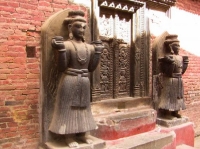 Anything that causes an increase or decrease in the proportion of the Fire Element in the bodily construction is considered by Ayurveda to be a fundamental cause of disease. All such diseases shift heat into the venous system. Things that have been found to increase the Fire Element during a Pitta disease, are called Pitta-aggravating agents. These include:
Anything that causes an increase or decrease in the proportion of the Fire Element in the bodily construction is considered by Ayurveda to be a fundamental cause of disease. All such diseases shift heat into the venous system. Things that have been found to increase the Fire Element during a Pitta disease, are called Pitta-aggravating agents. These include:
- Excessive or daily use of any kind of food, drug or herb that is sour or pungent or salty in taste, individually or in combination.
- Activity in the small intestine while food is still being digested.
- Overuse or daily use of alkaline foods or drugs, alcoholic beverages, burnt, roasted or fried foods, hot tea or coffee etc.
- Overuse or daily use of soybean products, sesame seed products, leafy green vegetables, rotten or stale food, over-ripe fruits, liquid diet, sugar or oily foods.
- Working near or exposure to the heat of the sun or fire.
- Excessive heavy labors or exercises.
- Over-eating, irregular meal times, or eating at the time of indigestion.
- Excessive use of foods, herbs or drugs with dilatory effect.
- The effect of autumn season, summer, or living in a hot climate.
- The natural Pitta effect of midday and midnight.
A healthy body can neutralize these agents if not in excess. However, these Pitta-aggravating agents during any condition of disease will increase activity in the vein system that will manifests as inflammatory symptoms or symptoms of infection. In this sense, Ayurveda present them as fundamental causes of disease concerned with the functions of (1) the vein system, (2) the Pitta substance and (3) heat energy.
Pitta in the Sense of Diagnosis
There are number of tests to help diagnose whether a disease is Pitta in character or has a Pitta component. These tests have to be carried out one by one to make a final decision about causation.
- Pain Test. Presence of burning sensation or pain is positive for Pitta causation.
- Touch Test. If a painful area becomes more painful from gentle pressure, this is positive for Pitta causation.
- Color Test. Presence of yellow, green or red colors in the affected tissue area, or the skin, complexion, stool, urine, nail etc., is a positive sign for Pitta causation.
- Small intestine activity test. If the symptoms of disease become worse while the small intestine is active digesting food (4-5 hours after intake), it is positive for Pitta causation.
- Time Test. If the symptoms of disease worsen in the midday and/or midnight, it is positive.
- Pulse Test. A strong, jumping pulse is positive.
- Seasonal Test. If the symptoms of disease are worse in autumn and/or summer, it is positive.
- Tastes Test. It is positive if the symptoms of disease worsen with the daily or excessive use of food or drugs or herbs that are sour or pungent or salty (or combinations of them). Feeling a bitter taste in the mouth is also positive for Pitta causation.
- Climate Test. If the symptoms of disease worsen in heat or tropical climates, it is positive for Pitta causation.
- Dilatory test. If the symptoms of disease worsen while using foods, herbs or drugs that have a strong dilatory effect, it is positive.
- Nature Test. If the symptoms of a disease are worse in aggressive, robust people (Pitta Prakriti) it is positive.
- Test of Mind. If the symptoms of disease become worse when irritated or angered, it is positive.
- Skin Test. If the affected area is slightly greasy, it is positive for Pitta causation.
- Swelling Test. If a swollen part does not change with pressure, it is positive.
- Fever test. If the temperature suddenly elevates or remains very high, it is positive.
- Preference Test. If the patient prefers cold, it is positive for Pitta causation.
Pitta in the Sense of Treatment
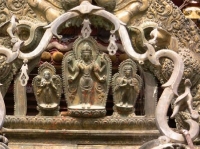 The fundamental theory of treatment concerning the diseases or the conditions of disease which are classified within the character of Pitta is based upon (1) practices that restore the balance of an over-balanced vein system or (2) subduing the over-powerful physical properties of the bile formula that cause heat. Ayurveda emphasizes that to restore the balance of the vein system in any part of the body the small intestine must first be cleaned with laxative or purgative drugs (see list on page 143), along with diuretics to flush the urinary system (see page Error! Bookmark not defined.).
The fundamental theory of treatment concerning the diseases or the conditions of disease which are classified within the character of Pitta is based upon (1) practices that restore the balance of an over-balanced vein system or (2) subduing the over-powerful physical properties of the bile formula that cause heat. Ayurveda emphasizes that to restore the balance of the vein system in any part of the body the small intestine must first be cleaned with laxative or purgative drugs (see list on page 143), along with diuretics to flush the urinary system (see page Error! Bookmark not defined.).
The Small Intestine and Bile
The small intestine is considered by Ayurveda to be the center of the sources of bile for the entire body. The bile that flows from the gall bladder to the small intestine has to be excreted during defecation and urination. Excess bile in the small intestine can be reabsorbed into the blood circulatory system where it causes over-activity in the vein system. This is because the physical properties of bile are similar to the physical properties of the Fire Element that are already more active in the blood of the veins.
Cleaning the small intestine means ridding the body of excess bile defecation and urination. When the supply of bile being reabsorbed is stopped or slowed, the body loses heat and the aggravated vein system calms down towards normal. Therefore, the use of laxative or purgative drugs along with diuretics has been found to be the most important method of cleaning the small intestine to quickly restore balance to the vein system. It is often the first thing ordered done by the physician in cases of inflammation.
The Tastes which Benefit Pitta
Sweet, bitter and astringent tastes individually or in combination in the form of food or herbs stimulate the activities of the artery system and the nervous system. These two systems working side-by-side are powerful methods of counteracting the overactive function of the vein system because the sweet, bitter and astringent tastes are counteractive to the sour, pungent and salty tastes that aggravate the function of the vein system. Therefore, foods or herbs that are sweet, bitter or astringent are prescribed as medicine to restore balance to the Pitta substance.
Some substances that are sweet, bitter or astringent tasting can cause heat that dilates the capillaries. To be effective, herbs or foods used against Pitta must have a cooling (Shita) effect. Otherwise, they cannot be used. If this rule is ignored it will result in more troubles. In the same way, any cooling herb, whatever its taste may be, can be used as a medicine to restore the balance of the vein system or the Pitta substance.
Some common herbs used to treat Pitta are:
- Rakta Chandanam wood (red sandalwood / Pterocarpus santalinus)
- Chandanam wood (white sandalwood / Santalum album)
- Parpata herb (Fumaria indica)
- Vasaka leaf (Malabar nut / Adhatoda vasica)
- Ushira rhizome (Andropogon muricatum)
- Nimba leaf (neem / Azadirachta indica)
- Haritaki fruit (Terminalia chebula)
- Bibhitaki fruit (Terminalia belerica)
- Kiratatiktam plant (Swertia chirata)
A reliable formula for treating Pitta is Kaisara Guggulu. Another formula for Pitta diseases, especially fevers, is Sudarsana churna.
Fasting and Bloodletting
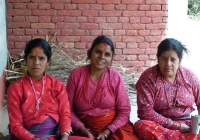 Fasting has medicinal value in the treatment of diseases classified in the character of Pitta. This can be done either without any food, or with a light amount of food or with a liquid diet. During fasting, there is less supply of bile from the digestive system. This creates fewer digestive by-products and reduces the supply of bile that causes heat. In this sense, the practice of fasting is beneficial to restore the balance of the vein system.
Fasting has medicinal value in the treatment of diseases classified in the character of Pitta. This can be done either without any food, or with a light amount of food or with a liquid diet. During fasting, there is less supply of bile from the digestive system. This creates fewer digestive by-products and reduces the supply of bile that causes heat. In this sense, the practice of fasting is beneficial to restore the balance of the vein system.
The practice of the bloodletting (venesection – see page 71) by using leeches or puncturing the vein has therapeutic value to restore the balance of the vein system. The blood in the veins generally contains lot of substances (toxins, bile etc.) that are hot in nature. It is obvious from empirical observation that the practice of bloodletting reduces the over-activity of the vein system. This practice is applied in general or for local treatment. Ayurveda emphasizes that directly taking out the “dirty” blood of the vein has unique and often powerful results in subduing the symptoms of diseases classified as Pitta.
Following the background logic of Ayurvedic principles, Pitta treatment includes:
- The use of laxative or purgative drugs with diuretics
- Sweet, bitter and astringent tasting foods or herbs
- Foods, herbs or other methods which have a cooling effect
- Fasting, and
- The practice of medical bloodletting.
0 Responses to “The Different Aspects of Pitta”